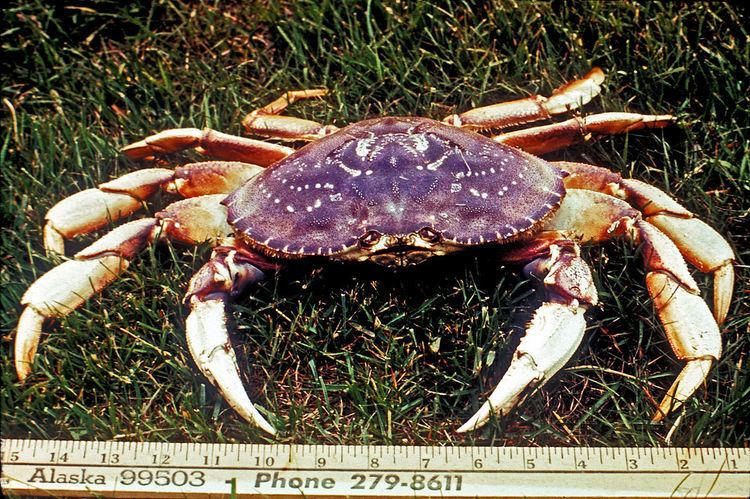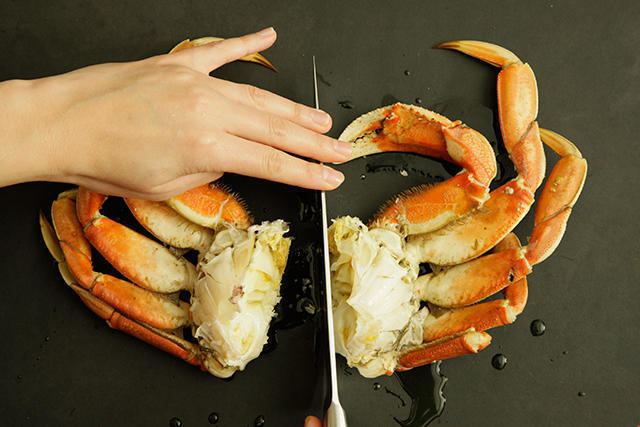Subphylum Crustacea Infraorder Brachyura Higher classification Cancer | Order Decapoda Rank Species | |
 | ||
Similar Crab, Chesapeake blue crab, Snow crab, Florida stone crab, King crab | ||
Oregon coast crabbing catching giant dungeness crab
The Dungeness crab, Metacarcinus magister (formerly Cancer magister), is a species of crab that inhabits eelgrass beds and water bottoms on the west coast of North America. It typically grows to 20 cm (7.9 in) across the carapace and is a popular seafood prized for its sweet and tender flesh. Its common name comes from the port of Dungeness, Washington.
Contents
- Oregon coast crabbing catching giant dungeness crab
- How to cook and clean a dungeness crab
- Description
- Life cycle and ecology
- Distribution
- Culinary use
- Sustainability
- State crustacean designation in Oregon
- References

How to cook and clean a dungeness crab
Description

The carapace widths of mature Dungeness crabs may reach 25 centimetres (9.8 in) in some areas off the coast of Washington, but are typically under 20 centimetres (7.9 in). They are a popular delicacy, and are the most commercially important crab in the Pacific Northwest, as well as the western states generally. The annual Dungeness Crab and Seafood Festival is held in Port Angeles each October.

Dungeness crabs have a wide, long, hard shell, which they must periodically moult to grow; this process is called ecdysis. They have five pairs of legs, which are similarly armoured, the foremost pair of which ends in claws the crab uses both as defense and to tear apart large food items. The crab uses its smaller appendages to pass the food particles into its mouth. Once inside the crab's stomach, food is further digested by the "gastric mill", a collection of tooth-like structures. M. magister prefers to eat clams, other crustaceans and small fish, but is also an effective scavenger. Dungeness crabs can bury themselves completely in the sand if threatened.
Life cycle and ecology
Mature female crabs generally molt between May and August, and mating occurs immediately after the female has molted and before the new exoskeleton hardens. Males are attracted to potential mates by pheromones present in the urine of females. Upon locating an available female, the male initiates a protective premating embrace that lasts for several days. In this embrace, the female is tucked underneath the male, oriented such that their abdomens touch and their heads face each other. Mating occurs only after the female has molted, and the female signals her readiness to molt by urinating on or near the antennae of the male. The female extrudes the eggs from her body several months later; however, they remain attached under her abdomen for three to five months until they hatch. Young crabs are free-swimming after hatching, and go through five larval stages before reaching maturity after about 10 molts or two years.
Juvenile crabs develop in eelgrass beds and estuaries where salinity levels tend to be low. The hyposaline conditions of the estuaries are lethal to some of the crab's parasites, such as Carcinonemertes errans which consumes a brooding female's live eggs. Dungeness crabs surveyed in Coos Bay were less likely to be infected by C. errans and have fewer parasites present on their carapace when inhabiting less saline waters farther inland.
Distribution
The Dungeness crab is named after Dungeness, Washington, which is located approximately five miles 5 miles (8.0 km) north of Sequim and 15 miles (24 km) east of Port Angeles. Its typical range extends from Alaska's Aleutian Islands to Point Conception, near Santa Barbara, California, while it is occasionally found as far south as Magdalena Bay, Baja California Sur, Mexico.
Dungeness crabs have recently been found in the Atlantic Ocean, far from their known range, raising concern about their possible effects on the local wildlife. Some Dungeness crab can be found as far east as Florida, North and South Carolina, and Alabama.
Culinary use
About one-quarter of the crab's weight is meat. The flesh has what is considered to be a delicate flavour and slightly sweet taste. Dungeness crabs can typically be purchased either live or cooked. Live crabs are cooked simply by dropping them into boiling salt water, waiting for a boil to return, and then allowing it to continue for 15 minutes, after which time the crabs are removed and placed into cold water to cool, and then cleaned. Another method of preparing crab is called half backing. Half backing is done by flipping the crab upside down and chopping it in half (from head to "tail"), after which the guts and gills can be scooped or hosed out. Many consider half backing to be superior to cooking the entire crab, because the meat is not contaminated by the flavor or toxins of the guts. Furthermore, half backed crabs boil faster or can be quickly steamed instead of boiled. Two common tools for removing crab meat from the shell are a crab cracker and a shrimp fork. Sometimes, a cleaver, mallet, or small hammer is used for cracking Dungeness crab, but the use of these devices is not recommended, as the integrity of the meat may be compromised due to the impact.
Sustainability
Seafood Watch has given the Dungeness crab a sustainable seafood rating of 'Good Alternative'. In 2014, 53 million pounds worth $170 million was harvested.
"State crustacean" designation in Oregon
In 2009, based on lobbying from schoolchildren at Sunset Primary School in West Linn, Oregon, and citing its importance to the Oregon economy, the Oregon Legislative Assembly designated the Dungeness crab as the state crustacean of Oregon.
